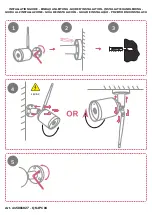
EPSON PhotoPC 3000Z
Revision A
Operating Principles
Circuit
48
Figure 2-14. Strobe Circuit Block Diagram
CHARGING CIRCUIT
When UNREG power is supplied to the charge circuit and the CHG signal
becomes High (3.3 V), the charging circuit starts operating and the main
electrolytic capacitor is charged with high-voltage direct current.
However, when the CHG signal is Low (0 V), the charging circuit does not
operate.
POWER SWITCH
When the CHG signal switches to Hi, Q5406 turns ON and the charging circuit
starts operating.
POWER SUPPLY FILTER
L5401 and C5401 constitute the power supply filter. They smooth out ripples
in the current which accompany the switching of the oscillation transformer.
OSCILLATION CIRCUIT
This circuit generates an AC voltage (pulse) in order to increase the UNREG
power supply voltage when drops in current occur. This circuit generates a
drive pulse with a frequency of approximately 50-100 kHz. Because self-
excited light omission is used, the oscillation frequency changes according to
the drive conditions.
OSCILLATION TRANSFORMER
The low-voltage alternating current which is generated by the oscillation
control circuit is converted to a high-voltage alternating current by the
oscillation transformer.
RECTIFIER CIRCUIT
The high-voltage alternating current which is generated at the secondary side
of T5401 is rectified to produce a high-voltage direct current and is
accumulated at electrolytic capacitor C5412 on the main circuit board.
VOLTAGE MONITORING CIRCUIT
This circuit is used to maintain the voltage accumulated at C5412 at a
constance level.
After the charging voltage is divided and converted to a lower voltage by
R5417 and R5419, it is output to the SY1 circuit board as the monitoring
voltage VMONIT. When this VMONIT voltage reaches a specified level at the
SY1 circuit board, the CHG signal is switched to Low and charging is
interrupted.
Summary of Contents for PhotoPC 3000Z
Page 5: ...Revision Status Revision Date of Issue Description A April 20 2000 First Release ...
Page 8: ...C H A P T E R 1 PRODUCT DESCRIPTIONS ...
Page 35: ...C H A P T E R 2 OPERATINGPRINCIPLES ...
Page 53: ...C H A P T E R 3 TROUBLESHOOTING ...
Page 57: ...C H A P T E R 4 DISASSEMBLYANDASSEMBLY ...
Page 70: ...C H A P T E R 5 ADJUSTMENT ...
Page 88: ...C H A P T E R 6 MAINTENANCE ...
Page 90: ...C H A P T E R 7 APPENDIX ...
Page 92: ......
Page 94: ......
Page 95: ......
Page 97: ......
Page 98: ......
Page 99: ......
Page 100: ......
Page 101: ......
Page 102: ......
Page 103: ......
Page 104: ......
Page 109: ......
















































